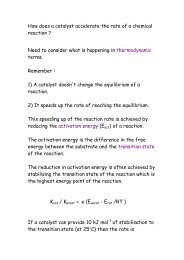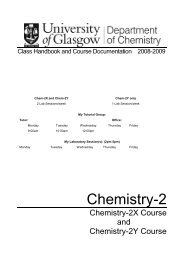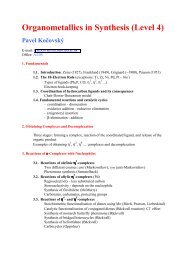ANSWERS CHEMISTRY-2X and CHEMISTRY 2Y ALL questions ...
ANSWERS CHEMISTRY-2X and CHEMISTRY 2Y ALL questions ...
ANSWERS CHEMISTRY-2X and CHEMISTRY 2Y ALL questions ...
You also want an ePaper? Increase the reach of your titles
YUMPU automatically turns print PDFs into web optimized ePapers that Google loves.
Someday January 2004<br />
11.00 a.m. – 12.00 p.m.<br />
Chemistry – 2<br />
Test 2<br />
<strong>ANSWERS</strong><br />
<strong>CHEMISTRY</strong>-<strong>2X</strong> <strong>and</strong> <strong>CHEMISTRY</strong> <strong>2Y</strong><br />
<strong>ALL</strong> <strong>questions</strong> should be answered, using a separate 12-page answer<br />
book for each section.<br />
Students taking just one module (e.g. Chem - <strong>2Y</strong> only) should attempt<br />
only <strong>questions</strong> from appropriate section.<br />
Section A: Chemistry <strong>2Y</strong><br />
Lecture Course Y2<br />
Lecture Course Y3<br />
GENERAL<br />
Section B<br />
Lecture Course X2<br />
Lecture Course X3<br />
GENERAL
O 3<br />
[2]<br />
Section A<br />
For Students doing the Chemistry <strong>2Y</strong> Course<br />
Question Y2 - CG<br />
The following mechanism has been proposed for the decomposition of ozone (O 3 ) in<br />
the atmosphere:<br />
k 1<br />
O 3<br />
O 2 + O<br />
k 1 '<br />
O + O 3 2 O 2<br />
What is the intermediate?<br />
[1]<br />
Use steady state theory to show that<br />
d ⎡O ⎤<br />
3<br />
k ⎡<br />
1<br />
O ⎤<br />
⎣ ⎦ 3<br />
= ⎣ ⎦<br />
dt<br />
'<br />
k ⎡<br />
1⎣O ⎤<br />
2⎦+<br />
k ⎡<br />
2<br />
O ⎤<br />
⎣ 3⎦<br />
[7]<br />
If the reaction of O <strong>and</strong> O 3 is slow, show that the reaction is first order with respect to<br />
k 2<br />
Answer to Question Y2 - CG<br />
O is the intermediate [1]<br />
[ ]<br />
dO =k O -k O O -k O O<br />
dt<br />
[ ]<br />
[ ]<br />
[ 3] 1[ 3]<br />
=<br />
'<br />
dt k [ O ]<br />
'<br />
[ ] [ ][ ] [ ][ ]<br />
1 3 1 2 2 3<br />
k1[ O3]<br />
'<br />
1[ 2] 2[ 3]<br />
2<br />
[ 3]<br />
2[ ][ 3 ]<br />
'<br />
[ ] [ ]<br />
Þ O = k O +k O<br />
dO3 kk<br />
1 2<br />
O<br />
=k O O =<br />
dt k O + k O<br />
when k = k<br />
'<br />
2 1<br />
dO k O<br />
1 2<br />
which is first order wrt O<br />
1 2 2 3<br />
3
Question Y3 - PK<br />
(a) Give a brief account of “aromaticity”, compare the aromaticity of carbocyclic<br />
(benzene) <strong>and</strong> heterocyclic compounds, such as furan (A) <strong>and</strong> pyridine (B), <strong>and</strong><br />
highlight the typical reactivity of aromatic compounds, such as benzene. Use<br />
specific examples <strong>and</strong> molecular formulae.<br />
[4]<br />
O<br />
N<br />
A B<br />
(b)<br />
Predict the major monochlorination products of the following substances (C <strong>and</strong><br />
D) <strong>and</strong> give your reasoning. Use molecular formulae <strong>and</strong> curly arrows <strong>and</strong><br />
clearly show the mechanism.<br />
[4]<br />
O OC 2 H 5<br />
C<br />
D<br />
OC 2 H 5<br />
(c)<br />
4-Bromopyridine (E) undergoes reaction with pyrrolidine to yield substitution<br />
product (F). Propose a mechanism for this reaction. Use molecular formulae <strong>and</strong><br />
curly arrows.<br />
[2]<br />
N<br />
Br<br />
N<br />
H<br />
N<br />
N<br />
+<br />
HBr<br />
E<br />
F<br />
Answer to Question Y3 - PK<br />
(a) As shown on my web-site; engage the correct electron pair in the conjugation<br />
(furan, pyridine).<br />
(b) C → m-; D → o- <strong>and</strong> p-.<br />
(c) Nucleophilic aromatic substitution at 2-position:
N Br N<br />
E<br />
HN ..<br />
H<br />
N<br />
Br<br />
N<br />
F<br />
N<br />
+<br />
HBr<br />
General Question <strong>2Y</strong> - SKA<br />
Draw all 7 isomers of C 4 H 10 O <strong>and</strong> name any 6 of them.<br />
[10]<br />
Answer to General Question <strong>2Y</strong> - SKA<br />
CH 3 CH 2 CH 2 OH, 1-butanol or n-butanol<br />
(CH 3 ) 2 CHCH 2 OH, 2-methyl-1-propanol or isobutanol<br />
(CH 3 ) 3 COH, 2-methyl-2-propanol or tert-butanol<br />
CH 3 CH 2 CH(OH)CH 3 , R- & S- 2-butanol (sec-butanol)<br />
(CH 3 CH 2 ) 2 O, diethyl ether<br />
CH 3 CH 2 CH 2 OCH 3 , methyl n-propyl ether<br />
(CH 3 ) 2 CHOCH 3 , methyl isopropyl ether<br />
half mark per structure, 1 mark per name
Section B<br />
For Students doing the Chemistry <strong>2X</strong> Course<br />
Question X2 - RAH<br />
(a) Draw the mechanism <strong>and</strong> clearly show the stereochemistry of the product<br />
formed when cyclohexene A is treated with bromine. [5]<br />
(b)<br />
(c)<br />
A<br />
Assign configurations, R or S, at each chiral centre in your product showing<br />
your priority assignment clearly.<br />
Draw the two possible conformations of your product <strong>and</strong> predict, with<br />
reasoning, which will be more stable.<br />
[2]<br />
[3]<br />
Answer to Question X2 – RAH (cont. over)<br />
Testing ILO’s 1,3,8,11,12<br />
(a)<br />
Br<br />
Br<br />
Br<br />
Br<br />
Br<br />
Mechanism [3], product [1], anti addition<br />
(b) R,R or S,S (depending which drawn)<br />
(c) chairs [2], diequatorial more stable<br />
Br<br />
[1]<br />
[2]<br />
[1]
Br<br />
Br<br />
Br<br />
Br<br />
Question X3 - JSJH<br />
MgO has the rock salt (sodium chloride) structure.<br />
(a) Assuming close packing of O 2- ions, describe the structure<br />
[3]<br />
(b) How many MgO formula units are there per unit cell<br />
[1]<br />
(c) Given that the lattice parameter, a, = 4.21 Å <strong>and</strong> again assuming close packing<br />
of O 2- , calculate:<br />
(i) the ionic radii of the O 2- <strong>and</strong> Mg 2+ ions<br />
[3]<br />
(ii) the crystallographic density<br />
[3]<br />
Atomic masses of O = 16, <strong>and</strong> Mg = 24, <strong>and</strong> Avogadro’s number = 6.022 x 10 23<br />
Answer to Question X3 – JSJH (cont. over)<br />
(a) A cubic close packed (or face centred cubic) array of oxygen ions with<br />
magnesium cations occupying all the octahedral holes.<br />
(b) Four.<br />
(c) (i) a 2 + a2 = (4r) 2 - four ionic radii touch across the diagonal<br />
= 2a 2 = 16r 2<br />
= a 2 = 8r 2<br />
= a= (8) 1/2 r<br />
therefore if a = 4.21Å, then rO 2- = 1.49Å<br />
each side of the unit cell comprises twice the radius of each ion, therefore:<br />
a-(2rO 2- ) = 2rMg 2+<br />
= rMg2+ = 0.62Å
I VII Cr VI Mo 0 [3]<br />
Alternatively, the size of the octahedral hole = 0.414rO 2- =0.62Å<br />
(ii) volume of unit cell = a 3 = 7.46x10 -23 cm 3<br />
mass of 4 MgO units = 4(24) + 4(16) / 6.022x10 23<br />
=2.656x10 -22 g<br />
as density = mass per unit volume<br />
then crystallographic density = 3.56g cm -3<br />
General Question <strong>2X</strong> - SKA<br />
(a) Assign oxidation numbers to the atom underlined in each of the following<br />
compounds.<br />
Na 2 [Fe(CN) 5 (NO)] (C 6 H 6 )Cr(CO) 3 NaOCl<br />
(b) Give the formulae of compounds which illustrate each of the following<br />
oxidation states (only one example is required in each case).<br />
[3]<br />
(c) Which of the above compounds might act as oxidising agents?<br />
[4]<br />
Answer to General Question <strong>2X</strong> - SKA<br />
(a) Fe III Cr 0 Cl I (+1)<br />
(b) NaIO 4 is the most likely, CrO 3 or K 2 Cr 2 O 7 but not CrCl 6 , Mo(CO) 6 or other<br />
realistic answer<br />
(c) Needs a high oxidation state so Fe III , Cl I , I VII <strong>and</strong> Cr VI but NOT Cr 0 or Mo 0 .<br />
1 mark for each correct answer in each case.


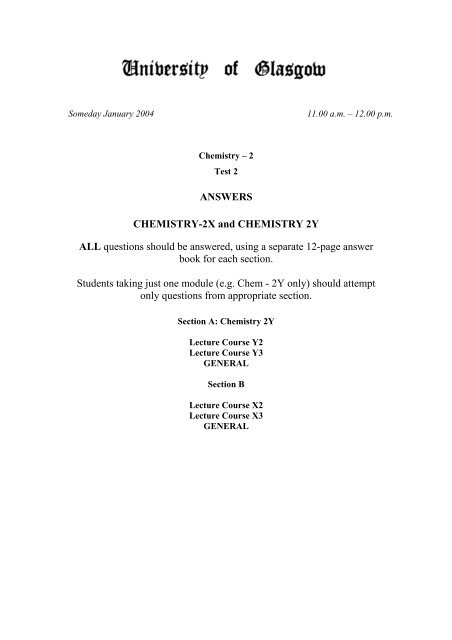
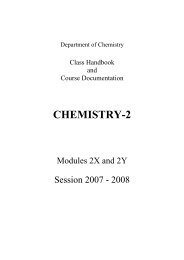

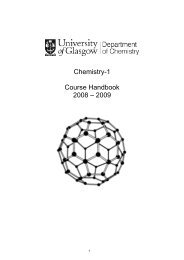
![Chemistry Study [PDF] - University of Glasgow](https://img.yumpu.com/26854063/1/184x260/chemistry-study-pdf-university-of-glasgow.jpg?quality=85)
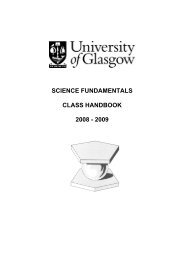
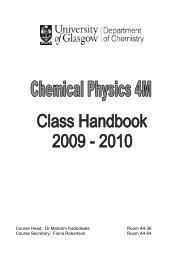
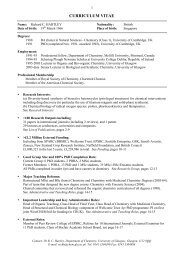

![Environmental Chemistry Study [PDF] - University of Glasgow](https://img.yumpu.com/26854018/1/184x260/environmental-chemistry-study-pdf-university-of-glasgow.jpg?quality=85)


